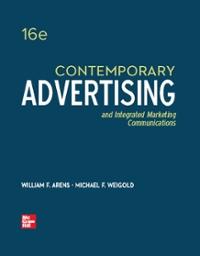Question
Case study question 500 employee stock options 197,521 Weighted average common shares outstanding, assuming dilution 6,210,238 19 Rocky Mountain Chocolate Factory Statement of Retained Earnings
Case study question 500
employee stock options 197,521 Weighted average common shares outstanding, assuming dilution 6,210,238 19 Rocky Mountain Chocolate Factory Statement of Retained Earnings For period ended February 28, 2010 Retained earnings, March 1, 2009 $5,751,017 Add: Net income 3,580,077 Less: Dividends (2,407,167) Retained earnings, February 28, 2010 $6,923,927 20 Rocky Mountain Chocolate Factory Balance Sheet As of February 28, 2010 Assets Liabilities and stockholders' equity Current assets Liabilities Cash and cash equivalents $3,743,092 Current liabilities Accounts receivable, less allowance for doubtful accounts 4,427,526 Accounts payable $877,832 Notes receivable, current 91,059 Accrued salaries and wages 646,156 Inventories 3,281,447 Other accrued expenses 946,528 Deferred income taxes 461,249 Dividends payable 602,694 Other 220,163 Deferred income 220,938 Total current assets $12,224,536 Total current liabilities $3,294,148 Property and equipment, net $5,186,709 Deferred income taxes 894,429 Other Assets Total liabilities $4,188,577 Notes receivable, less current portion $263,650 Equity Goodwill, net 1,046,944 Common stock $180,808 Intangible assets, net 110,025 Additional paid-in capital 7,626,602 Other 88,050 Retained earnings 6,923,927 Total other assets $1,508,669 Total stockholders' equity $14,731,337 Total Assets $18,919,914 Total liabilities and stockholders' equity $18,919,914Case 3: Rocky Mountain Chocolate Factory Financial Statements 18 Rocky Mountain Chocolate Factory Income Statement For period ended February 28, 2010 Revenues Sales $22,944,017 Franchise and royalty fees 5,492,531 Total revenues 28,436,548 Costs and expenses Cost of sales, excluding depreciation and amortization of $698,580 14,910,622 Franchise costs 1,499,477 Sales and marketing expenses 1,505,431 General and administrative expenses 2,422,147 Retail operating expenses 1,756,956 Depreciation and amortization 698,580 Total costs and expenses 22,793,213 Operating income 5,643,335 Other income (expenses) Interest income 27,210 Other, net 27,210 Income before income taxes 5,670,545 Income tax expense (2,090,468) Net income $3,580,077 Basic earnings per share $0.60 Diluted earnings per share $0.58 Weighted average common shares outstanding 6,012,717 Dilutive effect of employee stock options 197,521 Weighted average common shares outstanding, assuming dilution 6,210,238 19 Rocky Mountain Chocolate Factory Statement of Retained Earnings For period ended February 28, 2010 Retained earnings, March 1, 2009 $5,751,017 Add: Net income 3,580,077 Less: Dividends (2,407,167) Retained earnings, February 28, 2010 $6,923,927 20 Rocky Mountain Chocolate Factory Balance Sheet As of February 28, 2010 Assets Liabilities and stockholders' equity Current assets Liabilities Cash and cash equivalents $3,743,092 Current liabilities Accounts receivable, less allowance for doubtful accounts 4,427,526 Accounts payable $877,832 Notes receivable, current 91,059 Accrued salaries and wages 646,156 Inventories 3,281,447 Other accrued expenses 946,528 Deferred income taxes 461,249 Dividends payable 602,694 Other 220,163 Deferred income 220,938 Total current assets $12,224,536 Total current liabilities $3,294,148 Property and equipment, net $5,186,709 Deferred income taxes 894,429 Other Assets Total liabilities $4,188,577 Notes receivable, less current portion $263,650 Equity Goodwill, net 1,046,944 Common stock $180,808 Intangible assets, net 110,025 Additional paid-in capital 7,626,602 Other 88,050 Retained earnings 6,923,927 Total other assets $1,508,669 Total stockholders' equity $14,731,337 Total Assets
1. Which from the ensuing are topographies______ of a modern economy_________
2. When no firm or consumer is great enough______to affect tsdhdfcjksdksdkhe market price, the market is assumed to have_____
3. Which from the subsequent are the consequences of defective opposition in the markets__________
4. When one event happened before another event,__________ the fallacy in economic intellectual that the first occurrence instigated the additional event is called__________
5. When we assume that what is true for the part is__________ also true for the whole, we are committing___________
6. The three important economic difficulties ___________every human humanity must antagonize and resolve are__________
7. The three important economic problems __________-of what, how, and for whom are resolved by__________
8. Fiscal policy consists of government's_______________
9. The maximum amount of goods that can be professionally shaped by________-- an family using its scarce resources and available technology is called___________
10. Which economic period is secondhand________ to amount the overall presentation of an economy_________
Step by Step Solution
There are 3 Steps involved in it
Step: 1

Get Instant Access to Expert-Tailored Solutions
See step-by-step solutions with expert insights and AI powered tools for academic success
Step: 2

Step: 3

Ace Your Homework with AI
Get the answers you need in no time with our AI-driven, step-by-step assistance
Get Started


